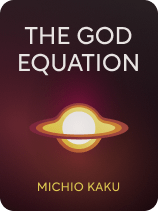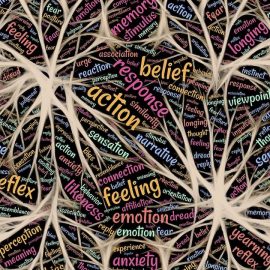

This article is an excerpt from the Shortform book guide to "The God Equation" by Michio Kaku. Shortform has the world's best summaries and analyses of books you should be reading.
Like this article? Sign up for a free trial here.
What’s string theory? How close is it to a unified theory of physics?
Physicists have yet to reconcile relativity, gravity, and quantum mechanics. But, according to Michio Kaku, string theory could be the solution. It’s the pioneering field that Kaku has been working to advance for all of his professional career.
Continue reading to learn about this thought-provoking theory and why Kaku finds it promising.
Michio Kaku on String Theory
We’ll explain what string theory is, how it suggests higher orders of symmetry in the universe, and why it appears that the universe we see is merely a projection of something much greater.
According to theoretical physicist Michio Kaku, string theory’s basic assertion is that all particles can be described as vibrations on subatomic strings that constitute the basis of energy and matter. He writes that each different type of particle is produced by a different vibration. One of string theory’s strong appeals is that its equations produce gravitons as being the lowest string vibration, removing the conflict between Einstein and quantum mechanics. String theory also supports physicists’ long-held belief that, in the beginning, there was one unifying force in the cosmos by showing that the particles transmitting those forces are symmetrically interchangeable since they’re all just different frequencies of the same foundational strings.
(Shortform note: A basic layman’s question that Kaku doesn’t address is that, if everything is made of vibrating strings, then what are those strings composed of? The answer physicists have to fall back on is that they’re not made of anything smaller—strings are the foundational building blocks of everything. In the old Standard Model, the universe’s fundamental units were a bestiary of zero-dimensional point particles (that also act as waves) interacting in fields of quantum uncertainty. String theory simplifies the Standard Model’s complexity by replacing those points with one-dimensional strings and explaining each different particle interaction as nothing more than different types of deformations on a string.)
Another argument in favor of string theory is that it introduces a new symmetry not present in previous theories. Kaku says that, in the Standard Model, there are two families of subatomic particles—bosons representing the fundamental forces, such as gluons, photons, and gravitons; and fermions comprising the building blocks of matter, such as protons, neutrons, and electrons. In the math for string theory, bosons and fermions are interchangeable, just like time and space are in relativity, as well as electricity and magnetism in Maxwell’s equations. This feature of string theory, called supersymmetry, unites every observable property of space, time, energy, and matter into the interactions of vibrating strings.
(Shortform note: The concept of supersymmetry was first introduced in 1974 by Mohammad Abdus Salam and John Strathdee in their work to define the electroweak force. They also introduced the concept of superspace, in which the x-y-z coordinate system to determine the location of any particle includes extra spatial dimensions where the coordinates are complex Grassman numbers. These are derived from a form of algebra invented by Hermann Grassmann, a 19th-century Prussian schoolteacher who had no idea that his work would be important to the realm of quantum physics 100 years later.)
String theory equations have bizarre implications, the most fundamental of which, according to Kaku, is that string theory works only if the universe has ten dimensions instead of the four that we’re aware of (three dimensions of space and one dimension of time). One hypothesis scientists use to explain this is to suggest that the other six dimensions we can’t see are so small that they’re imperceptible even on a subatomic scale. Another idea that Kaku puts forward is that our four-dimensional universe is a holographic image of the actual 10-D universe around us, just as an optical hologram is a 3-D image imprinted on a 2-D surface.
(Shortform note: Despite the impossibility of directly conceptualizing these extra, compacted dimensions Kaku describes, researchers are busy conceiving of ways their presence might be detected indirectly. One avenue involves supposing that the other dimensions aren’t as small as theorized. If so, then the three non-gravitational forces might be combined at much lower energies than previously imagined. Other possibilities are to observe particles disappearing into these dimensions or to watch for the effects of particles that can only exist in those dimensions.)
The trouble with these other six dimensions is that we don’t know what they represent, but their existence is required by string theory’s equations. For this reason among others, many scientists reject string theory as a piece of mathematical sleight-of-hand.
(Shortform note: Even before the time of Kaku’s writing, the supersymmetry component of string theory was meeting difficulties on the experimental front. Supersymmetry predicts a wide array of undiscovered subatomic particles in addition to those already known, and yet the Large Hadron Collider (LHC) hasn’t produced any trace of these expected new discoveries. While many theorists argue that the LHC may simply not be powerful enough to produce these particles, or that our detection methods are flawed, many others view the LHC’s lack of results in this area as evidence that string theory, while compelling, may nonetheless be wrong.)
Exercise: Reflect on String Theory
String theory offers a mathematical resolution for the many incongruities between the laws governing the fundamental forces. Does its lack of experimental evidence make you doubt it, or do you believe that an elegant mathematical solution is persuasive on its own? Why do you feel one way or the other?

———End of Preview———
Like what you just read? Read the rest of the world's best book summary and analysis of Michio Kaku's "The God Equation" at Shortform.
Here's what you'll find in our full The God Equation summary:
- The search for one theory that would unify all the rules of physics
- Why physicist Michio Kaku thinks string theory may hold the answer
- An explanation of string theory and the underlying symmetries of nature






